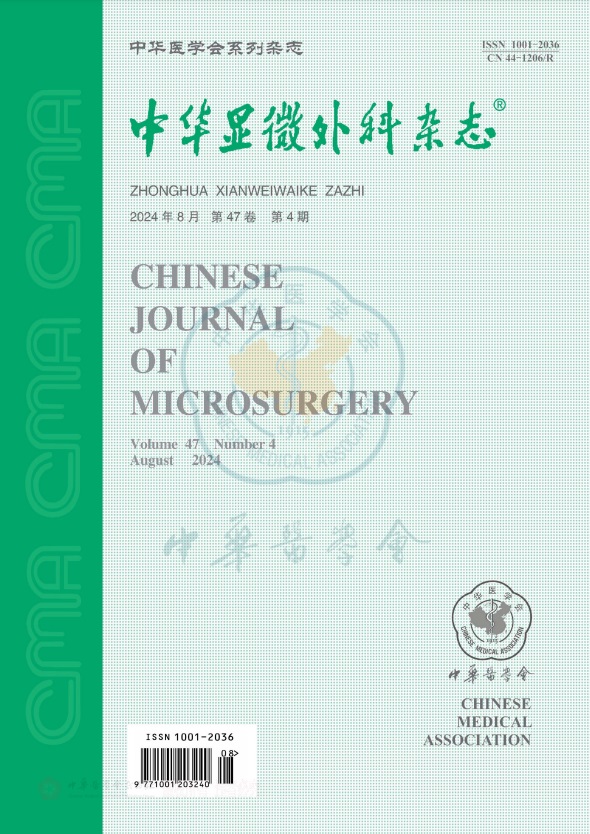Study on the reliability of NIRS to monitor fibular flaps on Rhesus monkeys
引用次数: 0
Abstract
Objective To confirm the sensitivity and validity of near-infrared spectroscopy (NIRS) technology to detect the dynamic changes of blood volume and regional tissue oxygen saturation (rSO2). Methods Six fibular flaps on Rhesus monkeys were raised simulating a clinical operation. Third generation of NIRS oxygen saturation oximeter (TSAH-100) was employed on Rhesus monkeys’ fibular flaps when its dominant artery and vein were blocked respectively or simultaneously, and then their relative changes of blood volume and oxygen saturation were observed and recorded in June, 2008 to October, 2008. Results The statistic results showed that concentration of deoxygenated hemoglobin (cHb), concentration of oxyhemoglobin (cHbO2) and rSO2 had rapid, apparent and distinct changes respectively in the case of arterial occlusion, venous occlusion and total occlusion. The initial values of cHb and cHbO2 of 3 models were 0 μmol/L. Meanwhile, the initial values of rSO2 in artery embolism, vein embolism and arteriovenous embolism were 51.6%, 54.3% and 56.8%, respectively. The maximum variations of cHb, cHbO2 and rSO2 in 3 models indicated significant difference compared with initial values (P<0.05) , the values of rSO2 after 6 s, 18 s and 8 s in 3 models had significant difference compared with initial values respectively (P<0.05) . Conclusion The TSAH-100 based on NIRS technology is an extraordinarily sensitive and reliable method to monitor the changes of oxygen saturation and blood perfusion in local tissue for buried flap within a depth of 2.0 cm. Key words: Near-infrared spectroscopy (NIRS); Oxygen saturation; Fibular flap; Buried flap; Rhesus monkey近红外光谱监测恒河猴腓骨皮瓣的可靠性研究
目的验证近红外光谱(NIRS)技术检测血容量和局部组织血氧饱和度(rSO2)动态变化的灵敏度和有效性。方法在恒河猴身上培养6个腓骨瓣,模拟临床手术。2008年6月至2008年10月,分别或同时阻断恒河猴腓骨皮瓣的优势动脉和静脉时,采用第三代近红外血氧饱和度仪(TSAH-100),观察并记录其血容量和血氧饱和度的相对变化。结果统计结果显示,动脉闭塞、静脉闭塞和全闭塞患者的脱氧血红蛋白(cHb)、氧合血红蛋白(cHbO2)和rSO2浓度变化迅速、明显、明显。3种模型的cHb和cHbO2初始值均为0 μmol/L。动脉栓塞、静脉栓塞和动静脉栓塞的rSO2初始值分别为51.6%、54.3%和56.8%。3个模型cHb、cHbO2和rSO2的最大变化量与初始值相比有显著差异(P<0.05), 3个模型在6 s、18 s和8 s后的rSO2值分别与初始值相比有显著差异(P<0.05)。结论基于近红外光谱(NIRS)技术的TSAH-100是一种非常灵敏、可靠的方法,可用于监测2.0 cm深埋皮瓣局部组织血氧饱和度和血流灌注的变化。关键词:近红外光谱;血氧饱和度;腓骨皮瓣;埋皮瓣;恒河猴
本文章由计算机程序翻译,如有差异,请以英文原文为准。
求助全文
约1分钟内获得全文
求助全文
来源期刊
CiteScore
0.50
自引率
0.00%
发文量
6448
期刊介绍:
Chinese Journal of Microsurgery was established in 1978, the predecessor of which is Microsurgery. Chinese Journal of Microsurgery is now indexed by WPRIM, CNKI, Wanfang Data, CSCD, etc. The impact factor of the journal is 1.731 in 2017, ranking the third among all journal of comprehensive surgery.
The journal covers clinical and basic studies in field of microsurgery. Articles with clinical interest and implications will be given preference.

 求助内容:
求助内容: 应助结果提醒方式:
应助结果提醒方式:


